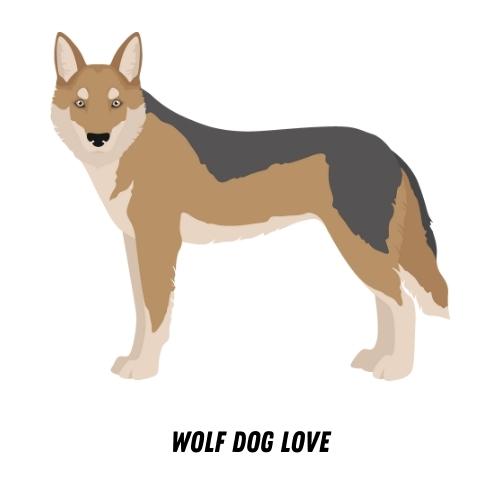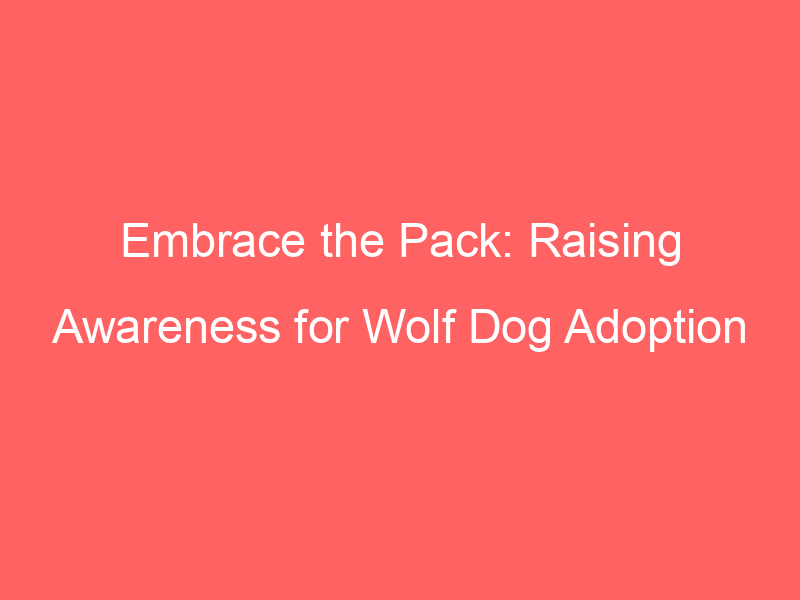Introduction to Wolf Dogs
Wolf Dogs are a fascinating blend of domestic dog and wild wolf. They are unique creatures that carry the traits of both their wolf and dog ancestors. In this article, we will delve into the world of Wolf Dogs, exploring their characteristics, behaviors, and the diversity within this intriguing species.
-
Understanding the term ‘Wolf Dog’
The term ‘Wolf Dog’ is used to describe a canine that has a wolf and a domestic dog in its family tree. These animals are not entirely wild, nor are they fully domesticated. They are a mix of both, which makes them incredibly interesting, but also challenging to understand and care for. Wolf Dogs can vary greatly in appearance and behavior, depending on the specific breeds and wolves in their ancestry.
-
Overview of Wolf Dog Species
Wolf Dogs are not a separate species, but rather a type of hybrid. They come from a mix of different dog breeds and wolf species. The most common wolf species in Wolf Dog ancestry are the Gray Wolf and the Eastern Timber Wolf. The dog breeds can vary widely, but German Shepherds, Siberian Huskies, and Alaskan Malamutes are often used due to their physical resemblance to wolves.
Here’s a brief overview of some common Wolf Dog types:
Type Wolf Content Common Dog Breeds in Mix High Content Wolf Dog 75% and above German Shepherd, Siberian Husky Mid Content Wolf Dog 50% – 74% Alaskan Malamute, Siberian Husky Low Content Wolf Dog 49% and below Various breeds
Exploring Wolf Dog Breeds
Wolf dogs are unique and fascinating creatures. They are a mix of domestic dogs and wolves, and they come in a variety of breeds. In this section, we will explore some of the most common wolf dog breeds.
Common Wolf Dog Breeds
There are several breeds of wolf dogs, but three of the most common ones are the Alaskan Malamute, the Siberian Husky, and the German Shepherd. Let’s take a closer look at each of these breeds.
- Alaskan Malamute
- Siberian Husky
- German Shepherd
The Alaskan Malamute is a large breed of domestic dog that was originally bred for their strength and endurance to haul heavy freight as a sled dog and hound. They have a strong wolf-like appearance, and are known for their friendly and affectionate nature. Despite their size, they are very gentle and good with children.
The Siberian Husky is a medium-sized working dog breed that originated in northeast Asia. They are known for their striking appearance which closely resembles that of wolves. Siberian Huskies are energetic and intelligent dogs. They are also known for their friendly demeanor and their ability to get along well with both humans and other dogs.
The German Shepherd is a breed of working dog known for its intelligence and versatility as a police, service and working dog. While they may not look as much like a wolf as the other breeds, they share many behavioral traits with wolves. German Shepherds are highly active and fun to train. They are often used in police and military roles because of their intelligence and trainability.
In conclusion, while these breeds may have physical and behavioral traits that are reminiscent of their wolf ancestors, they are domestic dogs with their own unique characteristics and traits. Whether you’re looking for a loyal companion, a working dog, or a family pet, these wolf dog breeds have a lot to offer.
Less Known Wolf Dog Breeds
While many people are familiar with popular wolf dog breeds like the Alaskan Malamute and the Siberian Husky, there are several less known breeds that are equally fascinating. Let’s explore two of these lesser-known wolf dog breeds: the Czechoslovakian Wolfdog and the Canadian Eskimo Dog.
- Czechoslovakian Wolfdog
The Czechoslovakian Wolfdog, also known as the Czechoslovakian Vlcak, is a unique breed that originated in Czechoslovakia in the 1950s. This breed was created by crossing a German Shepherd with a Carpathian wolf. The result is a dog that has the strength and endurance of a wolf combined with the intelligence and trainability of a German Shepherd.
These dogs are known for their loyalty and protective nature. They are also very active and require plenty of exercise. With their wolf-like appearance and striking yellow eyes, Czechoslovakian Wolfdogs are truly a sight to behold.
| Characteristic | Description |
|---|---|
| Size | Medium to large |
| Temperament | Loyal, protective, active |
| Exercise Needs | High |
- Canadian Eskimo Dog
The Canadian Eskimo Dog is one of the oldest and rarest indigenous dog breeds in North America. These dogs were originally bred by the Inuit people for pulling sleds in the harsh Arctic environment. They are known for their strength, endurance, and ability to withstand extremely cold temperatures.
Canadian Eskimo Dogs have a thick double coat, a bushy tail, and a powerful build. They are friendly and gentle with their families but can be reserved with strangers. Despite their strength, they are surprisingly agile and love to play.
| Characteristic | Description |
|---|---|
| Size | Large |
| Temperament | Friendly, gentle, reserved with strangers |
| Exercise Needs | High |
These less known wolf dog breeds, the Czechoslovakian Wolfdog and the Canadian Eskimo Dog, each have their unique characteristics and histories. They may not be as well-known as some other breeds, but they are equally deserving of our admiration and respect.
Understanding Wolf Dogs: Characteristics and Traits
Wolf dogs are unique animals that possess a blend of traits from both wolves and dogs. Let’s delve into understanding their physical characteristics and common traits.
- Physical Characteristics of Wolf Dogs
Wolf dogs are typically larger than most domestic dogs, with adult males often weighing between 70 and 125 pounds. Their coats come in a variety of colors, including white, black, gray, and brown. They have a broad head, large ears, and long legs, which are all characteristics of wolves. Their eyes can be brown or blue, and sometimes, they have one of each color.
One of the most noticeable physical characteristics of wolf dogs is their thick fur. This double coat helps them to stay warm in cold climates. It’s also important to note that wolf dogs shed their undercoat twice a year, which can result in a lot of fur around your home.
- Common Traits in Wolf Dogs
Wolf dogs are known for their intelligence and independence. They are often described as being more challenging to train than most domestic dogs due to their stubborn nature. However, with patience and consistency, they can learn to follow commands.
Wolf dogs are also known for their loyalty. Once they form a bond with their human, they are incredibly devoted. They are protective of their family and can be wary of strangers. This makes them excellent watchdogs, but it also means they need proper socialization from a young age to ensure they are comfortable around new people and situations.
It’s important to remember that every wolf dog is unique and their traits can vary widely. Some may be more dog-like, while others may have more wolf-like behaviors. Understanding these traits can help potential owners to provide the best care for their wolf dog.
| Characteristic | Description |
|---|---|
| Size | Large, weighing between 70 and 125 pounds |
| Coat | Thick double coat in a variety of colors |
| Temperament | Intelligent, independent, loyal, and protective |
| Socialization | Requires early and consistent socialization |
In conclusion, wolf dogs are a unique blend of wolf and dog characteristics. They are beautiful, intelligent, and loyal animals that require a dedicated and understanding owner. By understanding their traits and needs, you can provide a loving and suitable home for these remarkable creatures.
Wolf Dog Behavior: What to Expect
Wolf dogs are unique creatures, exhibiting a blend of traits from both their wolf and dog ancestors. Understanding their behavior is key to building a harmonious relationship with them. In this section, we will delve into the behavioral traits of wolf dogs in domestic settings.
Behavioral Traits in Domestic Settings
Wolf dogs, like any other pet, have their own unique ways of interacting with their environment. This includes their interactions with humans and other pets. Let’s take a closer look at these aspects.
- Interaction with Humans
- Interaction with Other Pets
Wolf dogs are known for their loyalty and protective nature. They form strong bonds with their human families and are often very affectionate. However, they can also be wary of strangers, and may require time to warm up to new people. It’s important to remember that patience and understanding are key when introducing a wolf dog to new human friends.
Wolf dogs can get along well with other pets, especially if they are raised together from a young age. However, their wolf instincts may sometimes surface, leading to a higher prey drive compared to other dogs. This means they might chase smaller pets. Supervision and proper socialization are crucial when introducing a wolf dog to other pets in the household.
In conclusion, wolf dogs are complex and fascinating creatures. Their behavior can be a blend of the wild instincts of a wolf and the domesticated traits of a dog. Understanding these behaviors can help in creating a safe and happy environment for your wolf dog and everyone in the household.
Behavioral Traits in Wild Settings
Wolf dogs exhibit unique behaviors when they are in the wild. These behaviors are primarily driven by their instinctual needs for survival and socialization. Let’s explore two of the most common behaviors: hunting and social behavior.
- Hunting Behavior
- Social Behavior
Wolf dogs, like their wolf ancestors, are natural hunters. They have a keen sense of smell, sharp eyesight, and swift movements, all of which are essential for hunting. In the wild, wolf dogs often hunt in packs, which allows them to take down larger prey. They use a combination of stalking, chasing, and strategic planning to catch their prey. For example, one wolf dog might distract the prey while the others surround it. This hunting behavior is a testament to their intelligence and teamwork.
Wolf dogs are also known for their social behavior. They live in packs, which are essentially their families. Each pack has a hierarchy, with an alpha male and female leading the group. The other members of the pack respect and follow the alpha pair. This social structure helps maintain order and harmony within the pack. Wolf dogs communicate with each other using a variety of signals, including body language, vocalizations, and scent marking. This social behavior is crucial for their survival in the wild.
In conclusion, the hunting and social behaviors of wolf dogs in the wild are fascinating. They demonstrate the wolf dogs’ intelligence, teamwork, and social structure. Understanding these behaviors can help us appreciate the complexity and beauty of these animals.
Appreciating Wolf Dog Differences: Embracing the Diversity
Wolf dogs are a unique blend of domestic dog and wild wolf. This combination results in a fascinating array of differences, particularly in their physical appearance. Let’s delve into the diversity of these magnificent creatures.
Diversity in Physical Appearance
Wolf dogs exhibit a wide range of physical characteristics that make each one unique. From their size to their coat color, these variations are a testament to the rich diversity of this breed.
- Variations in Size
- Variations in Coat Color
Wolf dogs can vary greatly in size, largely depending on the specific breeds involved in their lineage. Some wolf dogs may be as small as 50 pounds, while others can grow to over 100 pounds. This wide range in size is a reflection of the diverse genetic makeup of wolf dogs.
| Size Category | Weight Range |
|---|---|
| Small Wolf Dogs | 50-70 pounds |
| Medium Wolf Dogs | 70-90 pounds |
| Large Wolf Dogs | 90-100+ pounds |
Just as with size, the coat color of wolf dogs can also vary greatly. Some may have a coat that is pure white, while others may have a mix of gray, brown, black, or even red. This diversity in coat color is another aspect that makes each wolf dog unique.
| Coat Color | Description |
|---|---|
| White | Pure white coat, often seen in Arctic wolf dogs |
| Gray | Mix of black and white hairs, common in many wolf dogs |
| Brown/Red | Warm-toned coat, often seen in wolf dogs with certain dog breeds in their lineage |
| Black | Dark coat, can be seen in wolf dogs with specific wolf subspecies in their lineage |
These variations in size and coat color are just a few examples of the diversity that can be found in wolf dogs. Each wolf dog is unique, and this diversity is something to be appreciated and celebrated.
Diversity in Behavior
Just like humans, wolf dogs also have unique personalities and behaviors. This diversity in behavior can be seen in two main areas: temperament and social behavior.
- Variations in Temperament
Temperament refers to a wolf dog’s natural behavior or personality. Some wolf dogs may be more energetic and playful, while others might be more calm and reserved. This variation in temperament is largely due to their genetic makeup and upbringing.
For instance, a study conducted on a group of wolf dogs showed that those with a higher percentage of wolf genes tended to be more independent and less eager to please their human companions. On the other hand, wolf dogs with a higher percentage of dog genes were found to be more sociable and trainable.
- Variations in Social Behavior
Wolf dogs also show diversity in their social behavior. Some wolf dogs are very social and enjoy being around other animals and people. They may show their affection by wagging their tails, licking, and wanting to play. However, other wolf dogs may be more aloof or shy, preferring to keep to themselves.
It’s important to note that a wolf dog’s social behavior can be influenced by their early experiences. Wolf dogs that have been socialized from a young age are generally more comfortable around others. Those that haven’t had much social interaction may be more wary or anxious.
In conclusion, understanding the diversity in wolf dog behavior can help us appreciate these wonderful creatures even more. It’s a reminder that every wolf dog is unique and deserves to be treated with respect and understanding.
| Behavior Aspect | Description |
|---|---|
| Temperament | Refers to a wolf dog’s natural behavior or personality. Can be influenced by genetic makeup and upbringing. |
| Social Behavior | Refers to how a wolf dog interacts with other animals and people. Can be influenced by early socialization experiences. |
Conclusion: Celebrating the Varieties of Wolf Dogs
As we wrap up our exploration of wolf dogs, it’s important to remember that these animals are as diverse and unique as we are. Each breed has its own set of characteristics, behaviors, and traits that make it special. Let’s celebrate this diversity by embracing and appreciating the different varieties of wolf dogs.
- Embracing Wolf Dog Varieties
- Appreciating the Uniqueness of Each Wolf Dog
Wolf dogs come in all shapes and sizes, from the majestic Alaskan Malamute and Siberian Husky mixes to the smaller German Shepherd and Belgian Malinois crosses. Each breed brings its own unique blend of wolf and dog traits. Embracing these varieties means acknowledging the beauty and uniqueness of each breed. It’s about appreciating the strength and resilience of the Alaskan Malamute mix, the intelligence and agility of the Siberian Husky mix, and the loyalty and protectiveness of the German Shepherd mix. Each variety has something special to offer, and they all deserve our love and respect.
Just as no two humans are alike, no two wolf dogs are the same. Each animal has its own personality, quirks, and traits that make it unique. Some may be more playful and energetic, while others may be more reserved and independent. Some may have a strong prey drive, while others may be more content to lounge around the house. Appreciating the uniqueness of each wolf dog means understanding and respecting these differences. It means recognizing that each animal is an individual with its own needs, desires, and behaviors. It’s about celebrating the diversity within the wolf dog community and cherishing each animal for who they are.
In conclusion, wolf dogs are a diverse and fascinating group of animals. They are a testament to the beauty and diversity of nature, and they deserve our respect and admiration. So let’s celebrate the varieties of wolf dogs, and appreciate the uniqueness of each and every one of them.








